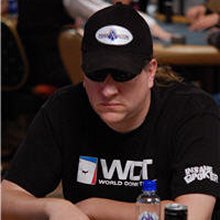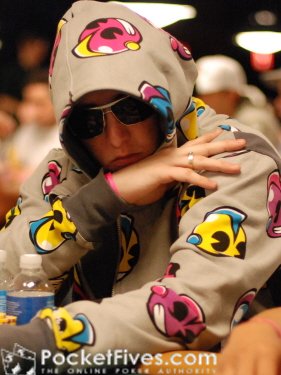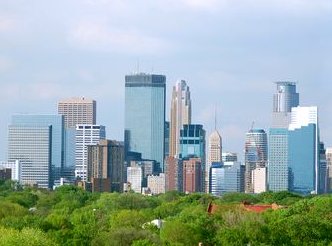State of Live Poker Post-Black Friday

 Black Friday had a major impact on poker players in the United States. In the last 19 months, many recreational players in the U.S. have left the game entirely, while several pros turned to live poker or moved using services like Poker Refugees. Turning to live poker was Chris Fox Wallace (pictured), who sat down with PocketFives to talk about the state of live poker in the United States. We’ll compare the immediate landscape post-Black Friday to the status quo, focusing on tournaments and tournament series.
Black Friday had a major impact on poker players in the United States. In the last 19 months, many recreational players in the U.S. have left the game entirely, while several pros turned to live poker or moved using services like Poker Refugees. Turning to live poker was Chris Fox Wallace (pictured), who sat down with PocketFives to talk about the state of live poker in the United States. We’ll compare the immediate landscape post-Black Friday to the status quo, focusing on tournaments and tournament series.
PocketFives: Talk about what happened to live poker immediately after Black Friday.
Chris Wallace: It took about six months to reach the peak. Within a week of Black Friday, I was meeting people whose screen names I knew online, but hadn’t seen in a live card room before. I also saw a lot of 24-year-olds with headphones and hoodies who I could obviously tell were online players.
In Las Vegas, it changed drastically. I went to the Wynn Classic this year and it was twice as tough as it had ever been before. At one point in a tournament there, I had Ty dabears87Reiman and Annette Annette_15 Obrestad to my left. That was a rough day.
PocketFives: How have live poker tournaments changed since October 2011, which marked the six-month anniversary of Black Friday?
 Chris Wallace: They’ve gotten good. I had never met lot of players who are regulars in the Midwest poker scene, like JohnnyGstaks (pictured), who was the #1 player in Minnesota for a while. Now, I am friends with them. JohnnyGstaks is at almost every tournament bigger than $300 in the Midwest.
Chris Wallace: They’ve gotten good. I had never met lot of players who are regulars in the Midwest poker scene, like JohnnyGstaks (pictured), who was the #1 player in Minnesota for a while. Now, I am friends with them. JohnnyGstaks is at almost every tournament bigger than $300 in the Midwest.
There are plenty of other people like this as well. There are six or seven of us who know each other and go to events, but had never traveled before. It has definitely been a big difference and those guys have gotten better as live players. I’ve gotten better too. I’ve changed the way I think about live poker and apply strategies that I had online.
PocketFives: What were some of the biggest challenges you faced when moving from online poker to live poker?
Chris Wallace: The biggest challenge was learning when to play differently live, like learning what rules we have online that we shouldn’t do live. Online, there was a lot more loose-aggressive play, more 3betting, and you had less of a read when someone was bad. Live, you have to learn when not to use some of those rules. It’s about realizing how different live play is.
PocketFives: How long did the process of figuring out the right strategy to use take you?
Chris Wallace: I think it was six months or a year for tournaments. Cash games were right away because I had been playing them a lot. Tournaments took me a while to see how soft the fields are, how high my ROI was, and how important it was not to bust out since there aren’t 10 other tournaments starting that I can register for.
I’ve played over 300 live tournaments with a $200 buy-in or bigger in the last year-and-a-half. My results got significantly better after the first six months. Now that the online players have learned to play live, the fields have gotten tougher, but my ROI has gone up because I’ve learned how to play them well. It’s a process that takes years. There is so much more to learn about interacting with your opponents and dealing with strong players.
 PocketFives: How have tournament series changed since Black Friday?
PocketFives: How have tournament series changed since Black Friday?
Chris Wallace: There has been a large increase in the number of tournament series. I just wrote an article for Minnesota Poker Magazine about how I can make a living without having to leave the Minnesota poker community. Here, I can make a living and probably do between $120,000 and $150,000 in tournament buy-ins in Minnesota for a year working full-time.
With my ROI, $120,000 to $150,000 in tournament buy-ins leaves me with a comfortable living without having to leave the state. If I travel a little bit, I can get that up to $250,000 without having to go to the WSOP. Two years ago, I couldn’t have gotten over $50,000 in buy-ins in Minnesota. Local rooms are realizing that a ton of players come in when they have series.
Younger guys come to these card rooms, play craps, and eat food, so tournament series bring in more money than they used to. Therefore, there are more of them. Every major series is growing and local series are starting to pop up all over the country.
 PocketFives: How did Full Tilt bankrolls being frozen change live poker?
PocketFives: How did Full Tilt bankrolls being frozen change live poker?
Chris Wallace: It had a big impact. $400 million was pulled out of the poker economy. Over the past year-and-a-half, that’s a lot of money that could have been won. It’s a bonanza for the backing companies. I’m not with one of the big backing companies, but I did pick up a backer after Black Friday. I didn’t have a choice, as Full Tilt decimated me.
Backing companies are putting so many good players in tournaments, but they are not playing as much as they could be and there’s not as much money in the poker economy. I think people have recovered a little bit, though. A lot of the online players who made the transition to live poker were in rough shape for the first six months, but have now recovered.
A lot of live players have also figured out other ways to make a little extra money. Everyone has something they can fall back on like a family business, investing in real estate, or a way to make money online.
Want the latest poker headlines and interviews? Follow PocketFives on Twitterand Like PocketFives on Facebook. You can also subscribe to our RSS feed.




